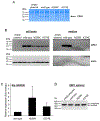Novel p.K374E variant of CPA1 causes misfolding-induced hereditary pancreatitis with autosomal dominant inheritance
- PMID: 31005883
- PMCID: PMC8596457
- DOI: 10.1136/gutjnl-2019-318751
Novel p.K374E variant of CPA1 causes misfolding-induced hereditary pancreatitis with autosomal dominant inheritance
Keywords: pancreas; pancreatic enzymes; pancreatitis.
Conflict of interest statement
Competing interests: None declared.
Figures


Comment in
-
Modelling chronic pancreatitis as a complex genetic disease in mice.Gut. 2023 Feb;72(2):409-410. doi: 10.1136/gutjnl-2022-327601. Epub 2022 May 16. Gut. 2023. PMID: 35577534 Free PMC article. No abstract available.
Comment on
-
Most unambiguous loss-of-function CPA1 mutations are unlikely to predispose to chronic pancreatitis.Gut. 2020 Apr;69(4):785-786. doi: 10.1136/gutjnl-2019-318564. Epub 2019 Mar 12. Gut. 2020. PMID: 30862690 No abstract available.
References
-
- Lin JH, Boulling A, Masson E, et al. Most unambiguous loss-of-function CPA1 mutations are unlikely to predispose to chronic pancreatitis. Gut 2020;69:784–5. - PubMed
Publication types
MeSH terms
Substances
Grants and funding
LinkOut - more resources
Full Text Sources
